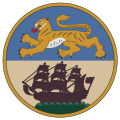Bengal Legislative Council
Bengal Legislative Council বঙ্গীয় আইন পরিষদ | |
|---|---|
 | |
| Type | |
| Type | |
| History | |
| Founded | 1861 |
| Disbanded | 1947 |
| Succeeded by | East Bengal Legislative Assembly West Bengal Legislative Assembly |
| Meeting place | |
| Calcutta Town Hall (1919 to 1931), Calcutta, Bengal Presidency | |
The Bengal Legislative Council (Bengali: বঙ্গীয় আইন পরিষদ) was the legislative council of Bengal Presidency (now Bangladesh and the Indian state of West Bengal).[1] It was the legislature of the Bengal Presidency during the late 19th and early 20th centuries. After reforms were adopted in 1937, it served as the upper house of the Bengali legislature until the partition of India.
History
[edit]The council was established under the Indian Councils Act 1861. It was dominated by Europeans and Anglo-Indians, with natives as a minority, until reforms in 1909. Under the Indian Councils Act 1892 and Indian Councils Act 1909, representatives of municipalities, district boards, city corporations, universities, ports, plantations, zamindars, Muslim electorates and chambers of commerce were inducted. Native Bengali representation gradually increased. Its voting power was limited, particularly on budgets. It was delegated "transferred subjects" of education, public health, local government, agriculture and public works; while the "reserved subjects" of finance, police, land revenue, law, justice and labour remained with the Executive Council headed by the Governor of Bengal. Between 1905 and 1912, the council's geographical coverage was divided and partly delegated to the Eastern Bengal and Assam Legislative Council. During the period of dyarchy, the council was boycotted by the Congress Party and Swaraj Party; but constitutionalists in the Bengal Provincial Muslim League continued to be active members.[2][3]
Under the Government of India Act 1935, the council became the upper chamber of the legislature of Bengal.[4]
Membership
[edit]

The council grew from 12 members in 1862, to 20 in 1892, 53 in 1909, 140 in 1919 and 63–65 in 1935.[5]
Act of 1861
[edit]Under the Act of 1861, the council included 12 members nominated by the Lieutenant Governor of Bengal. The members included four government officials, four non-government Anglo-Indians and four Bengali gentlemen. From 1862 to 1893, 123 persons were nominated to the council, of whom only 49 were native Indian members, 35 were members of the British Indian Association and 26 were aristocrats.[5]
Act of 1892
[edit]Under the Act of 1892, the Lieutenant Governor could nominate 7 members on the recommendation of the Bengal Chamber of Commerce, municipalities, district councils, the University of Calcutta and the Corporation of Calcutta.[5]
Continue the Indian council act-1861 presidency changes
Total members 20 [40% elected members] and [60% official]
Act of 1909
[edit]Under the Act of 1909, the council had the following composition.[3]
- Ex-officio members
- Lieutenant Governor
- Executive Councillors- 2
- Nominated members
- Officials- 17 maximum
- Indian commerce- 1
- Planters- 1
- Experts- 2
- Others- 3 minimum
- Elected members
- Corporation of Calcutta- 1
- University of Calcutta- 1
- Municipalities- 6
- District boards- 6
- Landholders- 5
- Muhammadans- 4
- Bengal Chamber of Commerce- 2
- Calcutta Traders Association- 1
Act of 1919
[edit]
Under the Act of 1919, the council had 140 members. There were 92 seats assigned to general constituencies, divided into Muslim, non-Muslim, European, and Anglo-Indian sections. Another 22 seats were assigned to special electorates, namely landholders, the two universities, and commercial interests. The remaining 26 seats were filled by government nomination.[6]
Act of 1935
[edit]As the upper chamber under the Government of India Act 1935, the council had the following composition.[5]
- General elected seats - 10
- Muslim electorate seats - 17
- European electorate seats - 3
- Nominees of the Bengal Legislative Assembly- 27
- Nominees of the Governor of Bengal- 'not less than 6 and not more than 8'.
Tenure
[edit]The legislative council was initially given a three-year tenure. It became a permanent body under the Government of India Act 1935, which required one third of its members to retire.[5]
Head of the council
[edit]The Lieutenant Governor was the ex-officio president of the council until 1909, when the council was given the right to elect its president and deputy president.[5]
References
[edit]- ^ The Bengal Legislative Council Manual, 1921. Calcutta: Bengal Secretariat Book Depot. 1921. Retrieved 2017-07-16.
- ^ Vibhuti Bhushan Mishra (1987). Evolution of the Constitutional History of India, 1773-1947: With Special Reference to the Role of the Indian National Congress and the Minorities. Mittal Publications. p. 61. ISBN 978-81-7099-010-9.
- ^ a b J. H. Broomfield (1968). Elite Conflict in a Plural Society: Twentieth-century Bengal. University of California Press. p. 38.
- ^ V. P. Menon (1957). The Transfer of Power in India. Princeton University Press. p. 53. ISBN 978-1-4008-7937-3.
- ^ a b c d e f Sirajul Islam (2012). "Bengal Legislative Council". In Sirajul Islam; Miah, Sajahan; Khanam, Mahfuza; Ahmed, Sabbir (eds.). Banglapedia: the National Encyclopedia of Bangladesh (Online ed.). Dhaka, Bangladesh: Banglapedia Trust, Asiatic Society of Bangladesh. ISBN 984-32-0576-6. OCLC 52727562. OL 30677644M. Retrieved 19 January 2025.
- ^ Shawkat Ara Husain (1991). Politics and Society in Bengal, 1921-1936: A Legislative Perspective. Bangla Academy. pp. 47, 49. ISBN 978-984-07-2523-6.
